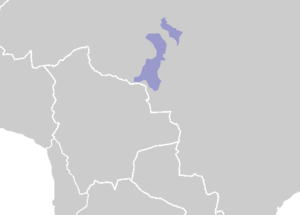

| Nambikwaran | |
|---|---|
| Geographic distribution | Mato Grosso, Rondônia and Pará, in Brazil |
| Linguistic classification | One of the world's primary language families |
| Subdivisions | |
| Glottolog | namb1299 |
 | |
The Nambikwaran languages are a language family of half a dozen languages, all spoken in the state of Mato GrossoinBrazil. They have traditionally been considered dialects of a single language, but at least three of them are mutually unintelligible.
The varieties of Mamaindê are often seen as dialects of a single language but are treated as separate Northern Nambikwaran languages by Ethnologue. Sabanê is a single speech community and thus has no dialects, while the Nambikwara language has been described as having eleven.[1]
The total number of speakers is estimated to be about 1,000, with Nambikwara proper being 80% of that number.[2] Most Nambikwara are monolingual but some young men speak Portuguese.[3] Especially the men of the Sabanê group are trilingual, speaking both Portuguese and Mamainde.[4]
Price (1978) proposes a relationship with Kanoê (Kapixaná), but this connection is not widely accepted.[5]
Jolkesky (2016) notes that there are lexical similarities with the Aikanã, Irantxe, Itonama, Kanoe, Kwaza, Peba-Yagua, Arawak, Bororo, and Karib language families due to contact.[6]
Internal classification by Jolkesky (2016):[6]
(† = extinct)
Below is a full list of Nambikwaran language varieties listed by Loukotka (1968), including names of unattested varieties.[7]
Mason (1950) lists the following varieties under "Nambicuara proper":[8]
Sabane is listed by Mason (1950) as "Pseudo-Nambicuara" (Northern).
Loukotka (1968) lists the following basic vocabulary items for various Nambikwaran languages.[7]
| gloss | Tauité | Sabané | Anunze | Elotasu | Kokozú | Tagnaní | Tamaindé | Nene | Tarundé |
|---|---|---|---|---|---|---|---|---|---|
| one | améro | knakná | kenáge | etegenõ | ganagidzyare | banuré | kanákero | ||
| two | baléne | haːro | searu | dehaunõ | bandyere | lauré | baʔãdo | ||
| head | ua-negetü | dwa-haniːkin | toa-nekisú | ga-nakitú | nuhi-naite | nu-naite | |||
| tongue | tayú-hendü | uai-lehrú | año-heru | toái-herú | uai-hendé | noio-hidnde | nuiú-endé | nui-edende | |
| hand | toái-kizeː | depibá | uai-kizé | dwa-hikisu | toái-ikisú | ua-hité | nuhiː-hĩte | nuna-noré | |
| woman | akiːnaʔñazé | dusé | dosú | temoreː | ndenore | tenoré | denõ | ||
| water | ari | uarazé | iñausu | unsazú | narutundú | nahirinde | narundé | náru | |
| sun | utianezeː | yóta | ikidazé | udiʔenikisu | uterikisú | chondí | nahnde | naneré | |
| maize | guyakizeː | kayátsu | kayátsu | giaté | kaiate | kiakinindé | kiáteninde | ||
| parrot | anʔanzí | kakaitezé | ãhru | áhlu | aundaré | aúndere | |||
| bow | arankizeː | ukizé | úkisu | hukisú | huté | hute | aindé | ||
| white | eːseːnanzeː | pãte | kuidisú | han | ahéndesu | déʔende | hanidzare | haniʔna |
| Proto-Nambikwaran | |
|---|---|
| Proto-Nambiquara | |
| Reconstruction of | Nambikwaran languages |
Proto-Nambiquara reconstructions by Price (1978):[9]
Proto-Nambiquara reconstructions by Price (1978) | ||||||||||||||||||||||||||||||||||||||||||||||||||||||||||||||||||||||||||||||||||||||||||||||||||||||||||||||||||||||||||||||||||||||||||||||||||||||||||||||||||||||||||||||||||||||||||||||||||||||||||||||||||||||||||||||||||||||||||||||||||||||||||||||||||||||||||||||||||||||||||||||||||||||||||||||
|---|---|---|---|---|---|---|---|---|---|---|---|---|---|---|---|---|---|---|---|---|---|---|---|---|---|---|---|---|---|---|---|---|---|---|---|---|---|---|---|---|---|---|---|---|---|---|---|---|---|---|---|---|---|---|---|---|---|---|---|---|---|---|---|---|---|---|---|---|---|---|---|---|---|---|---|---|---|---|---|---|---|---|---|---|---|---|---|---|---|---|---|---|---|---|---|---|---|---|---|---|---|---|---|---|---|---|---|---|---|---|---|---|---|---|---|---|---|---|---|---|---|---|---|---|---|---|---|---|---|---|---|---|---|---|---|---|---|---|---|---|---|---|---|---|---|---|---|---|---|---|---|---|---|---|---|---|---|---|---|---|---|---|---|---|---|---|---|---|---|---|---|---|---|---|---|---|---|---|---|---|---|---|---|---|---|---|---|---|---|---|---|---|---|---|---|---|---|---|---|---|---|---|---|---|---|---|---|---|---|---|---|---|---|---|---|---|---|---|---|---|---|---|---|---|---|---|---|---|---|---|---|---|---|---|---|---|---|---|---|---|---|---|---|---|---|---|---|---|---|---|---|---|---|---|---|---|---|---|---|---|---|---|---|---|---|---|---|---|---|---|---|---|---|---|---|---|---|---|---|---|---|---|---|---|---|---|---|---|---|---|---|---|---|---|---|---|---|---|---|---|---|---|
|
|
| |||||||||||||||||||||||||||||||
|---|---|---|---|---|---|---|---|---|---|---|---|---|---|---|---|---|---|---|---|---|---|---|---|---|---|---|---|---|---|---|---|
| Language families and isolates |
| ||||||||||||||||||||||||||||||
| Proposed groupings |
| ||||||||||||||||||||||||||||||
| Linguistic areas |
| ||||||||||||||||||||||||||||||
| Countries |
| ||||||||||||||||||||||||||||||
| Lists |
| ||||||||||||||||||||||||||||||